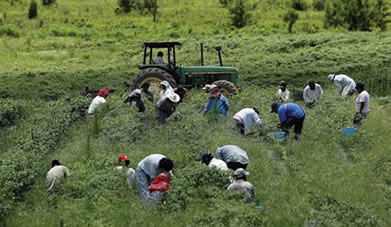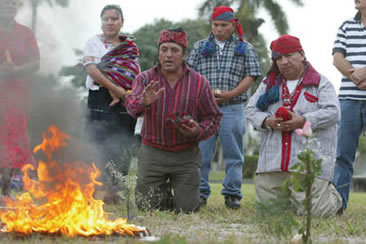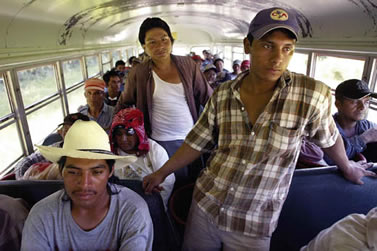|
|
 Religion in TransitionUniversity of Florida Researchers are Gaining a Better Understanding of the Role Religion Plays in the Lives of Hispanic ImmigrantsBy Jessica Gordon Puebla, Mexico, may be nicknamed “The City of Angels,” but for 45-year-old Miguel, Puebla provided little work to support his eight children. So in 1999 Miguel journeyed alone from Puebla to the United States in search of a better life. He was recruited on the border to harvest crops in Immokalee, Florida, where he knew no one. During the past five years, Miguel has worked in Florida, the Carolinas, Kentucky, Virginia and Maryland — returning home only once to visit his family. “When I’m sleeping and I ask God to support me to take care of my family because I’m far away from my family, I ask Him to take care of us and I always put myself in God’s hands,” Miguel says. Migrant workers pick hot peppers at Richard Kenda Farms in Madison County, Florida. Kenda’s crews are paid by the hour for picking zucchini, squash, peppers Miguel, who was raised Catholic, rarely attends church in Immokalee and, although he identifies with a Pentecostal church in Puebla, believes God does not recognize any particular religion. Religion has always played a major role in the lives of American immigrants, from the Pilgrims at Plymouth Plantation to European Catholics and Jews at Ellis Island to the millions of Latin American immigrants arriving in places like Immokalee. Although modern technology allows even the poorest immigrants to maintain closer ties to their homelands through telephones and the Internet, many still rely on prayer and their local church as a source of comfort and community in their adopted homes. “For transnational migrants in poor and displaced communities, religion is an important resource to draw upon,” says University of Florida political science Professor Phillip Williams. Churches and temples are often the first things established in immigrant neighborhoods, adds Manuel Vasquez, an associate professor of religion. Williams, Vasquez and religion Associate Professor Anna Peterson have been studying religion in Latino immigrants’ lives for a decade. Between 1995 and 1998, they conducted an extensive study of Catholic and Protestant congregations in Peru, El Salvador and the United States. The research, funded by a $300,000 grant from the Pew Charitable Trusts, resulted in a book titled Christianity, Social Change and Globalization in the Americas. “The three of us had been working on the subject of religion and social change in Latin America for several years before that,” Williams says. “By joining forces, we could do cross-national and cross-regional studies in Latin America and the United States, as well as strengthen ties with colleagues internationally.” The researchers observed and interviewed people in places as diverse as Paterson, New Jersey, and Lima, Peru. The forms of worship ranged from traditional patron saint celebrations to former gang members reciting poetry. “These images reflect the diverse and sometimes unexpected faces of Christianity in the Americas today,” the researchers write in the preface to their book. “In former war zones and in immigrant neighborhoods, centuries-old festivals for patron saints mix with commemorations of martyrs to political violence. Everywhere, men, women and children seek healing from different types of demons, spiritual and material.” The research found that at the local level, religion helps people — especially womenand youth — solidify their identities and confront challenges of the modern world. Vasquez says religion provides a social framework as immigrants move between countries and cultures. The mixing of peoples results in hybrid forms of religious beliefs and practices, which both challenge and enrich established religious institutions. “A large percentage of Latinos are Protestants, some Brazilians practice African-based religions in addition to Catholicism, and Mexicans and Guatemalans often practice Native American traditions because of their indigenous heritage,” he says.
Mayan priest Roberto Poz Perez from Guatemala (center) makes an offering
With this emphasis on “lived religion” and the group’s other findings, their research could have important implications for Florida and the rest of the United States as the Latino population grows. “Unlike early-1900s immigrants who settled in urban areas where communities were already established, these new Hispanic immigrants increasingly favor non-traditional locations such as the South and Midwest, states that haven’t seen large immigrant populations,” Williams says. He says the new research — which focuses on immigrants from Mexico, Guatemala and Brazil — exemplifies the Ford Foundation’s commitment to projects that reduce poverty and injustice and promote international cooperation. Williams says these multi-locale “traveling ethnographies” are vital to understanding migration, identity and religious diversity. “We wanted to choose understudied Latino immigrants in non-traditional areas like Jupiter, Fla., and Immokalee, Fla.,” Williams says. “We purposely didn’t choose Miami.” The study focuses specifically on the three groups because of their differences: Guatemalans and Brazilians are relatively new to the state, while Mexicans have a long history of migration to Florida. “There is diversity even within the national groups,” Williams says. “Every state in Mexico is represented in Immokalee, Fla.” Brazilians tend to be more urban, many with university degrees, while Guatemalans and Mexicans are traditionally from the countryside and more agrarian. Although Brazilians are not Hispanic, the Euro-Americans among whom they live see them as part of the same Latino culture. The team has found that this perception has an effect on the way Brazilians see themselves and relate to other Latinos. Cubans were purposely not addressed because of the wealth of existing research on Cuban immigration, and Cubans’ established visibility and clout in South Florida. To gather the information, the researchers immerse themselves in the immigrant communities. They conduct interviews and focus groups and collect oral histories, placing particular emphasis on the variables of gender and life cycle. Vasquez says that the most surprising finding thus far is the extent to which immigrants without social networks quickly build social relations. “Part of the study is to encourage immigrants to talk to each other about commonalities,” he says. “Networks are built from scratch very quickly, and churches play a big role, even in sports, food and entertainment.” Not everything comes as easy for these new residents. “When immigrants come in large numbers to communities that aren’t used to them, there is conflict and misunderstanding,” Vasquez says. In Jupiter, an affluent city north of West Palm Beach, residents are happy to have migrant day laborers to fill the high demand for cheap labor in landscaping and building construction. But residents also have complained about seeing those same workers standing on street corners in the morning waiting to be picked up by labor contractors. “Migrant visibility is seen by some as a stain on the community,” Williams says. Organizations in the area, such as Corn Maya, have proposed building a labor center where migrant workers could wait to be picked up, and be hired from, but the city commission is split — some members don’t want tax dollars spent on undocumented immigrants. “This is a microcosm of what’s happening in many communities in the United States, predominantly in Anglo-Saxon communities,” Vasquez says. In the same Jupiter community, county leaders worked with immigrant groups to hold a Mayan cultural festival on the campus of Florida Atlantic University’s honors college. “The festival became news in Guatemala, and a Guatemalan radio station actually broadcast the festival by cell phone,” Williams says. The research provides a glimpse into how Latino immigration is changing public life in Florida and how it is likely to make an impact on the rest of the state. “Our research is not just academic, but social,” Vasquez says. “One of the goals of the project is to aid in the formation of a network that connects immigrant groups and provides shared information and resources.” The study also hopes to bring about changes in local government policy. “We hope the research will not only bring visibility but also create solutions through outreach programs to reconcile conflicts,” Williams says. The most challenging part of the research is sustaining contact with immigrants in the study. Because the harvest season lasts only six or seven months in places like Immokalee, Williams says migrants don’t stay in one residence for very long. When the harvest ends, migrants go north to Georgia and North Carolina, then on to Tennessee and Indiana. Brazilians have a large presence in Atlanta, while Guatemalans have flocked to Washington D.C.
Migrant workers at Richard Kenda Farms in Madison County, Florida ride from the zucchini fields to the pepper fields.
An international conference is planned for December 2005 that will bring together project faculty, members of the group’s advisory board, community and religious leaders, and scholars to discuss theoretical and policy implications of the study, as well as strengthen networks of scholars and policymakers. Then, beginning in 2006, the researchers will begin studying the immigrants’ communities of origin to compare them with established U.S. communities. “We will then extend to other parts of the United States where these groups are forming new communities,” Vasquez says. “Florida is a bellwether state, and a lot of trends here are being reproduced nationally,” Williams says. “This research is not just telling for the future of Florida but also for the future of the whole United States.”
Manuel Vasque Philip J. Williams Related Web site: |


